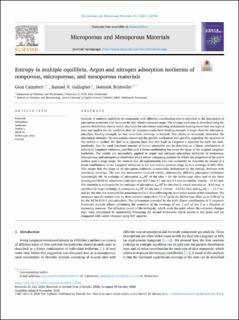Please use this identifier to cite or link to this item:
https://doi.org/10.21256/zhaw-21141Full metadata record
| DC Field | Value | Language |
|---|---|---|
| dc.contributor.author | Calzaferri, Gion | - |
| dc.contributor.author | Gallagher, Samuel | - |
| dc.contributor.author | Brühwiler, Dominik | - |
| dc.date.accessioned | 2020-12-30T16:04:16Z | - |
| dc.date.available | 2020-12-30T16:04:16Z | - |
| dc.date.issued | 2021-01 | - |
| dc.identifier.issn | 1387-1811 | de_CH |
| dc.identifier.uri | https://digitalcollection.zhaw.ch/handle/11475/21141 | - |
| dc.description.abstract | Analysis of multiple equilibria of compounds with different coordination sites is extended to the description of adsorption isotherms with focus on the low relative pressure range. The entropy evolution is described using the particle distribution theory which also holds for adsorbents consisting of materials bearing more than one type of sites and applies for the condition that the adsorptive-adsorbent binding strength is larger than the adsorptive- adsorbate binding strength, so that monolayer coverage is favored. This allows to accurately determine the adsorption enthalpy. No assumption concerning the growth mechanism and specifics regarding the structure of the surface is needed. We find on a rigorous basis that this leads to Langmuir’s equation for each site inde-pendently, that the total fractional amount of bound adsorptive can be described as a linear combination of individual Langmuir isotherms, and that such a linear combination has never the shape of the original Langmuir isotherms. The results are successfully applied to argon and nitrogen adsorption isotherms of nonporous, microporous, and mesoporous adsorbents which allows comparing systems for which the properties of the active surface span a large range. We observe that all experimental data can accurately be described by means of a linear combination of two Langmuir isotherms in the low relative pressure range up to a coverage of 60%–95%. This means that the shape of all adsorption isotherms is essentially determined by the entropy decrease with increasing coverage. The two site interactions involved exhibit substantially different adsorption enthalpies. Interestingly the Ar enthalpy of adsorption ΔadsH∅1 of the sites 1 for the St¨ober-type silica and of the three investigated MCM-41 adsorbents (with pore size of 2.7 nm, 4.1 nm, and 4.4 nm) are similar, namely 11 kJ/mol. The situation is analogous for the enthalpy of adsorption ΔadsH∅2 for the sites 2, which amounts to 8 kJ/mol. A significantly larger enthalpy of adsorption ΔadsH∅1 for the sites 1, namely 14.3 kJ/mol, and ΔadsH2∅ = 11.7 kJ/mol for the sites 2 is measured for potassium zeolite L thus reflecting the more polar nature of this adsorbent. The measured specific surface area for these samples ranges from 14 m2/g for the St¨ober-type silica up to 1100 m2/g for the MCM-41(4.1 nm) adsorbent. The information provided by the lc2-L (linear combination of 2 Langmuir functions) analysis allows calculating the evolution of the coverage of site 1 and of site 2 as a function of increasing pressure. The inflection points of the isotherms, which mark the point where the curvature changes sign, were determined by numerically evaluating the second derivatives which vanish at this point and are compared with values obtained using BET analysis. | de_CH |
| dc.language.iso | en | de_CH |
| dc.publisher | Elsevier | de_CH |
| dc.relation.ispartof | Microporous and Mesoporous Materials | de_CH |
| dc.rights | http://creativecommons.org/licenses/by/4.0/ | de_CH |
| dc.subject.ddc | 540: Chemie | de_CH |
| dc.title | Entropy in multiple equilibria : argon and nitrogen adsorption isotherms of nonporous, microporous, and mesoporous materials | de_CH |
| dc.type | Beitrag in wissenschaftlicher Zeitschrift | de_CH |
| dcterms.type | Text | de_CH |
| zhaw.departement | Life Sciences und Facility Management | de_CH |
| zhaw.organisationalunit | Institut für Chemie und Biotechnologie (ICBT) | de_CH |
| dc.identifier.doi | 10.1016/j.micromeso.2020.110744 | de_CH |
| dc.identifier.doi | 10.21256/zhaw-21141 | - |
| zhaw.funding.eu | No | de_CH |
| zhaw.issue | 110744 | de_CH |
| zhaw.originated.zhaw | Yes | de_CH |
| zhaw.publication.status | publishedVersion | de_CH |
| zhaw.volume | 312 | de_CH |
| zhaw.publication.review | Peer review (Publikation) | de_CH |
| zhaw.funding.snf | 172805 | de_CH |
| zhaw.webfeed | Polymerchemie | de_CH |
| zhaw.funding.zhaw | Multimodal Porous Particles | de_CH |
| zhaw.author.additional | No | de_CH |
| zhaw.display.portrait | Yes | de_CH |
| Appears in collections: | Publikationen Life Sciences und Facility Management | |
Files in This Item:
| File | Description | Size | Format | |
|---|---|---|---|---|
| 2020_Calzaferri-Gallagher_etal_Entropy-in-multiple-equilibria.pdf | 5.39 MB | Adobe PDF |  View/Open |
Show simple item record
Calzaferri, G., Gallagher, S., & Brühwiler, D. (2021). Entropy in multiple equilibria : argon and nitrogen adsorption isotherms of nonporous, microporous, and mesoporous materials. Microporous and Mesoporous Materials, 312(110744). https://doi.org/10.1016/j.micromeso.2020.110744
Calzaferri, G., Gallagher, S. and Brühwiler, D. (2021) ‘Entropy in multiple equilibria : argon and nitrogen adsorption isotherms of nonporous, microporous, and mesoporous materials’, Microporous and Mesoporous Materials, 312(110744). Available at: https://doi.org/10.1016/j.micromeso.2020.110744.
G. Calzaferri, S. Gallagher, and D. Brühwiler, “Entropy in multiple equilibria : argon and nitrogen adsorption isotherms of nonporous, microporous, and mesoporous materials,” Microporous and Mesoporous Materials, vol. 312, no. 110744, Jan. 2021, doi: 10.1016/j.micromeso.2020.110744.
CALZAFERRI, Gion, Samuel GALLAGHER und Dominik BRÜHWILER, 2021. Entropy in multiple equilibria : argon and nitrogen adsorption isotherms of nonporous, microporous, and mesoporous materials. Microporous and Mesoporous Materials. Januar 2021. Bd. 312, Nr. 110744. DOI 10.1016/j.micromeso.2020.110744
Calzaferri, Gion, Samuel Gallagher, and Dominik Brühwiler. 2021. “Entropy in Multiple Equilibria : Argon and Nitrogen Adsorption Isotherms of Nonporous, Microporous, and Mesoporous Materials.” Microporous and Mesoporous Materials 312 (110744). https://doi.org/10.1016/j.micromeso.2020.110744.
Calzaferri, Gion, et al. “Entropy in Multiple Equilibria : Argon and Nitrogen Adsorption Isotherms of Nonporous, Microporous, and Mesoporous Materials.” Microporous and Mesoporous Materials, vol. 312, no. 110744, Jan. 2021, https://doi.org/10.1016/j.micromeso.2020.110744.
Items in DSpace are protected by copyright, with all rights reserved, unless otherwise indicated.